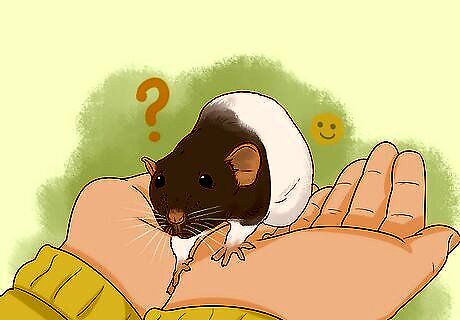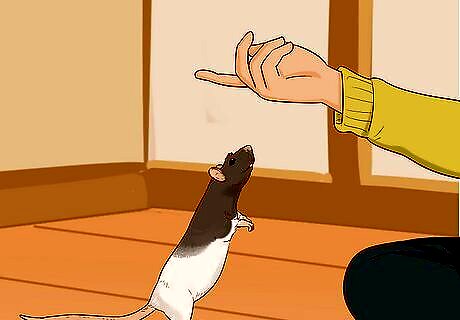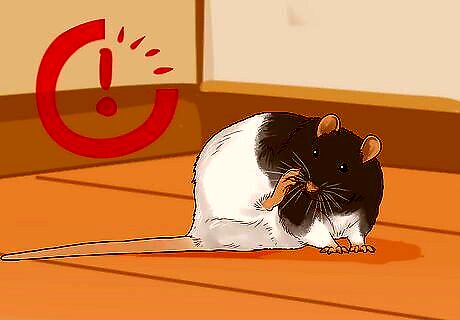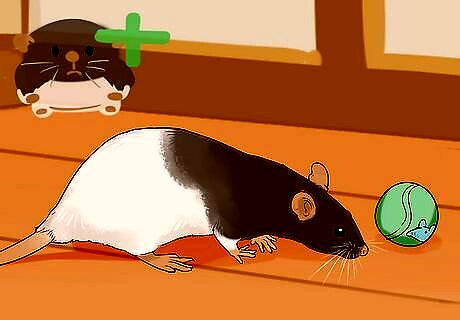
views
Creating the Right Environment

Rat-proof any rooms and spaces you’ll be training in. Always train your rat outside of its cage, such as on the floor. Never train your rat on a table or chair as it may fall off. Make sure the room is rat-proof so you keep your rat safe. You don't want your rat running off or getting hurt! Close up any exits, remove other animals, and move electrical cords and wires that it could chew on. You should also get rid of any chemicals or substances it could eat. Your rat's safety should be your first concern! You should also remove any objects your rat could get under.

Create a safe space for your rat. Rats enjoy spending time with their humans outside of their cages. However, you should make sure your rat feels safe. Start by training in a quiet room that doesn’t have any other animals in it. Make sure that you only do activities with your rat that makes it feel safe. Doing this will help build trust between you and your rat. Your rat may bite you if it’s scared.

Spend time with your rat before you begin training. Spending time with them is so important! To train your rat, you need to spend time with them and build a relationship. Your rat will easier to train and more willing to learn if it trusts you and feels a bond. Spend some time playing with your rat, getting to know it, and getting it used to you.Tip: Get your rat used to you by placing a spoon with food inside the cage and letting it eat from the spoon. After your rat starts to sniff your arm, try picking it up and holding it. Never pick it up by its tail because this could scare it.
Establishing Basic Training Techniques

Teach behaviors using hand signals. These are often used for training dogs, but incorporating hand signals into training sessions with your rat can help it understand what you want it to do. For example, to teach your rat to sit, you could hold your hand out straight and turn it so your palm is facing up. Then, lift your hand up above your rat’s head so it will look at it. Make sure to reward your rat with a treat after it performs the desired behavior. EXPERT TIP Brian Starr Brian Starr Rat Specialist & Breeder Brian Starr is a Rat Specialist and Breeder and the Owner of OC Dumbos out of Central Florida. As America’s only breeder of pet Roof Rats, Brian and OC Dumbos specialize in rat breeding, training, and care. Years of experience and several generations of careful breeding have allowed Brian and OC Dumbos to create a line of tame Roof Rats, bred to make friendly, fun pets. In addition to offering rat accessories and training resources, OC Dumbos also offers free Roof Rat adoptions. Brian Starr Brian Starr Rat Specialist & Breeder Reward training wins with tiny treats. Hide healthy treats around their enclosure as positive rewards to motivate them to willingly learn tricks and tasks. Treats will provide consistent, food-based reinforcement during play time.

Use positive reinforcement to encourage your rat. The best way to train a rat is through positive reinforcement. Your rat will want to perform for you if it knows it will get a treat! This encourages the rat to perform the desired action so it can get the treat. You can use rat treats that have been cut into small pieces, verbal praise, and toys as rewards.Tip: You can phase out the treats slowly as your rat gets better at responding to your cues. Start giving a treat only every other time your rat performs the desired behavior, then every third time, and then not at all. Reserve treats for teaching your rat new tricks.

Eliminate distractions. It's easier to train your rat in a really quiet place with no disruptions. Rats are naturally curious and will want to explore their surroundings, so training in the same place can help lower distractions. Choose a safe location where you are unlikely to be interrupted. For example, you might train your rat on your bedroom floor with the door closed and all wires and other hazards up and out of its reach.

Keep training sessions short. Your rat has a short attention span, so you don't want to overdo it! Remember, your rat gets tired, too. Training for long periods of time will not make your rat learn better and may actually set back your training. Instead, train for short periods. Keep the sessions around 10 to 15 minutes. If your rat seems uninterested in training, put it back in its cage and try again later.

Base the tricks on your rat’s personality. Getting to know your rat's individual personality is important for training! Some rats are better at some tricks that others, and not every rat can do the same thing. All rats are intelligent and can be trained, but evaluate your rat’s personality to figure out if it seems to like or be good at something. Remember, not all rats will learn the same tricks the same way. Some rats are more motivated than others, so be patient and take the time needed with each individual rat.
Teaching Specific Tricks

Teach the rat to come when called. Place your rat a little bit away from you. Hold a treat out so your rat notices it. When it comes to get the treat, reward it by giving it the treat. Don’t pair a verbal cue with the action and reward until your rat can perform it consistently. Once the behavior is 100% consistent, start pairing the hand signal with a verbal command such as “come.” Repeat the word while the rat comes to you and gesture with your hand, such as by motioning towards yourself. When the rat comes to you, give it the treat and praise it with pets or holding. If your rat's name is more than two syllables long, try using a nickname or shortened version instead.Tip: Try a shorter distance at first, then longer as your rat starts understanding the concept.

Train the rat to stand. Place the rat on a flat surface. Take a treat and say “stand.” As the rat sniffs the treat, lift the treat to guide the rat upward. Your rat will probably stand up to follow the treat in your hand. When it stands, give it the treat and praise. Each time you get your rat to stand, raise the treat higher to try to get them to stand straighter. When you start to phase out the treats, continue to raise your hand as if you’re holding something in it.

Consider teaching a rat to shake hands. To make your rat shake your hand, put a treat in your hand near the rat's paws. Then slowly and very gently, take your rat’s paw and put it on the treat. Say "shake" and then feed the treat to your rat. You could also try holding the treat in your closed fist with 1 finger outstretched as you do this. Allow your rat to grip or “shake” your outstretched finger.

Try teaching your rat to clap. You can teach the rat to clap by holding a treat above its head. Say the word “clap!” and the rat should try to grab the treat with both hands. Make sure to hold it at a place where both the hands meet when it reaches. When it claps, give it the treat and praise.

Carry your rat around on your shoulder cautiously. Rats love to ride on their humans’ shoulders, but they can fall off and get injured, so be very careful if you decide to do this. Place the rat on your shoulder, and then give it a treat. Hold it gently in place as you let it get used to being on your shoulder. Give it another treat or two while it stays put. As the rat gets used to being on your shoulder you can slowly start moving by standing up and then walking. Keep providing plenty of treats and stroking your rat to reassure them.




















Comments
0 comment